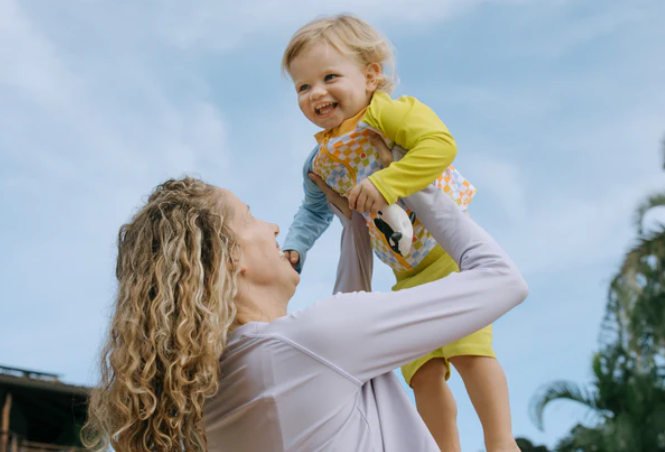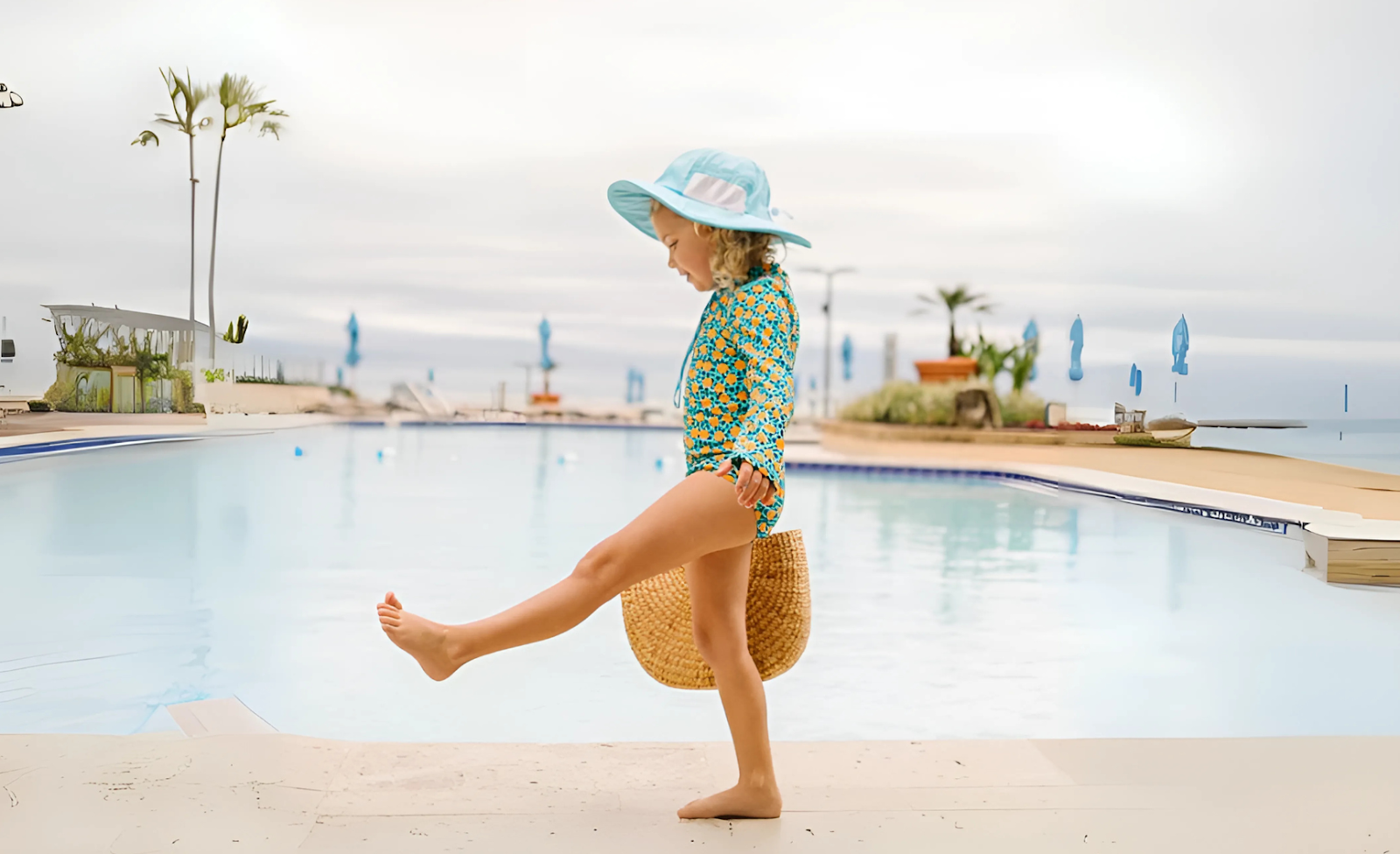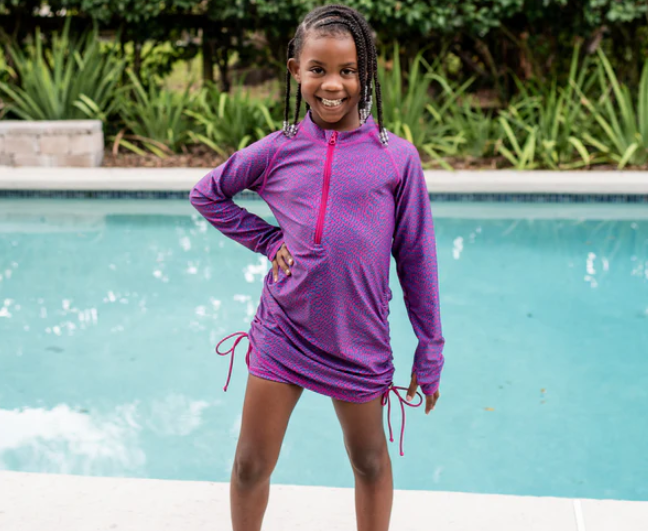
Are rash guards better than other swimsuits for babies?
Rash guards are a type of swimsuit that protects the upper body from UV rays and abrasion. Designed to protect surfers, they are the best upper body swimwear for babies, children, and adults. Since rash guards fit like an overshirt, they can be worn over girls’ one-piece swimsuits, T-shirts, or other upper-body swimwear to control sun exposure.
We’ll discuss swimwear options for babies, how to dress them for different water situations, and how to shop for sun-protective babies’ swimwear so you can protect your little ones against UV rays and rashes.
Do babies need swimwear?
Babies should wear swimsuits. Newborns under 6 months can splash naked in shallow, warm water for short periods, but any extended water play calls for coverage.
- Sun damage happens fast: A baby's skin burns after 10–15 minutes of sun exposure. Even on cloudy days, up to 80% of harmful UV rays penetrate clouds. Water and sand reflect these rays, creating a double exposure that can cause serious sunburn or sun poisoning.
- Babies can’t regulate temperature yet: They lose body heat faster than adults. Cool water, air conditioning, or ocean breezes can quickly drop their core temperature. Swimwear provides that important extra layer of warmth to keep them comfortable.
- Water isn't always clean: Public pools, lakes, and beaches harbor bacteria that can irritate sensitive skin. A barrier between your baby's skin and potentially contaminated water reduces infection risk.
- Sensitive skin needs protection: Rough pool edges, sand, and salt water can irritate bare skin. Swimwear creates a protective buffer that lets babies focus on fun.
Every situation is different. Match swimwear to your plans to keep your baby safe and comfortable. Check out our mommy and me matching sets for coordinated family looks, or browse our guide to mixing and matching swimwear for photo styling tips.
What should a baby wear to swim?
The best baby swimwear choice depends on where your baby is swimming and what your priorities are. Here's how to match swimsuit types to different situations.
Outdoor swimming and beach days
Rash guard swimsuits are best for outdoor water activities. Choose options with UPF 50+ fabric that blocks 98% of harmful UV rays. Whether you’re at the beach, outdoor pools, or water parks, rash guards handle extended sun exposure while keeping your baby comfortable and safe. Pair them with swim trunks, swim skirts, one-piece swimsuits, or any other bottom you like.
Indoor swimming pools
At indoor swimming pools, dress your baby for the water temperature. If the temperature is warm and the pool deck isn't cold, one-piece swimsuits or swim trunks work great. Some indoor facilities blast the air conditioning, and rash guards can keep your baby warm.
Easy diaper access
When you know diaper changes will be frequent, like with potty training toddlers or babies who tend to have accidents, rash guards paired with easy-access bottoms are your best friend. Since rash guards only cover the upper body, you can quickly change swim diapers without removing the top. Pair them with swim trunks or swim skirts that pull down easily.
Budget-conscious choices
The most economical way to protect your kid with the least amount of pieces. Budget-conscious parents should either buy a full-body surf suit or pair a rash guard top with high-coverage swim bottoms. For families who swim mostly indoors or very occasionally, basic one-piece swimsuits are fine, but don't skimp on protection if you plan to swim outdoors.
SwimZip's baby sun-protective swimwear features all these quality materials with UPF 50+ protection built right in. Every piece keeps your little one safe while looking adorable, splash after splash.
What to look for when buying baby swimwear
Shopping for babies’ swimwear isn’t overwhelming when you know what to look for. Prioritize:
- Adjustable sizing: Look for drawstrings, multiple snap positions, or stretchy materials that accommodate growth spurts and provide a secure fit.
- Quality fabric: Soft fabric blends with spandex offer comfort and flexibility, while quick-drying, chlorine-resistant material maintains color and shape through frequent washing. Look for UPF 50+ fabric, which provides the highest level of sun protection available in swimwear.
- Safety-first designs: Built-in zipper garages prevent pinching delicate skin, reinforced stitching for comfort reduces chafing, and secure closures keep suits in place during active play.
- Age-appropriate functionality: Easy-access designs work best for 3-month-old babies, while older babies need increased mobility for transition from water to land activities.
Shop SwimZip's baby sun-protective swimwear collection
SwimZip's swimwear combines maximum sun protection with adorable designs that make water time safer and more fun. Start with our baby sun-protective swimwear collection for rash guards, one-pieces, and swim sets. From newborn essentials to toddler favorites, we've got every age covered with quality pieces that last.
Our themed collections make choosing fun. Browse the baby boys’ collection or check out seasonal prints like daisy, rainbow, and Hawaiian patterns that bring personality to pool days.
Mix and match with confidence using coordinating pieces from our gingham and color block collections. These versatile designs mix and match easily, whether you're planning family photos or just heading to the pool.
Every SwimZip baby piece carries the Skin Cancer Foundation Seal of Recommendation, giving you confidence that your little swimmer has the best protection available. Shop now and make every water adventure safer and more stylish.
Babies’ rash guard vs swimsuits FAQ
Do kids get hot in rash guards?
Quality rash guards made from lightweight fabrics and quick-drying materials help regulate body temperature by blocking the sun and allowing airflow. The extra sun protection prevents overheating from sun exposure, which is often worse than any warmth from the extra fabric. Look for breathable spandex blends that move with your baby and dry fast.
Does a 3-month-old need a swimsuit?
3-month-old babies need swimwear for any water activity lasting more than a few minutes. Their delicate skin burns fast, and they can't regulate body temperature like adults. Rash guards pair with swim trunks, swim skirts, or swim diapers for easy changing access.
Should a rash guard be tight?
Rash guards should fit snugly without restricting movement or breathing. Loose fits allow water to enter freely and reduce body temperature. Tight fits cause discomfort and limit the range of motion. The fabric should lie flat against the skin with enough stretch for active play. Check that armholes and necklines seal without pinching.
Is a rash guard the same as a wetsuit?
Rash guards and wetsuits are different. Rash guards provide sun protection and basic abrasion resistance, while wetsuits are thicker and offer better insulation and abrasion resistance. Rash guards use lightweight, quick-drying materials that keep your baby comfortable in warm conditions, whereas wetsuits use thick neoprene.
Why is it called a rash guard?
The name "rash guard" comes from the skin problem it was designed to solve. When surfers spend long periods lying on their surfboards, paddling out to waves, the constant rubbing of their chest and stomach against the rough, textured surface causes painful skin irritation. This friction rash, called "board rash," was a common problem for surfers. The tight-fitting shirts we call rash guards prevent chafing and rash.
Is a rash guard only for swimming?
Rash guards aren't just for swimming. They’re handy for pools and water activities, but also for any outdoor fun where kids need sun protection. You'll see them at playgrounds, on beach walks, during sports, or just as comfy summer shirts. Many parents use them as regular warm-weather clothing because they block UV rays. They're basically sun protection that also happens to work in water.
Further reading
How to keep your kids safe during summer



Leave a comment
This site is protected by hCaptcha and the hCaptcha Privacy Policy and Terms of Service apply.